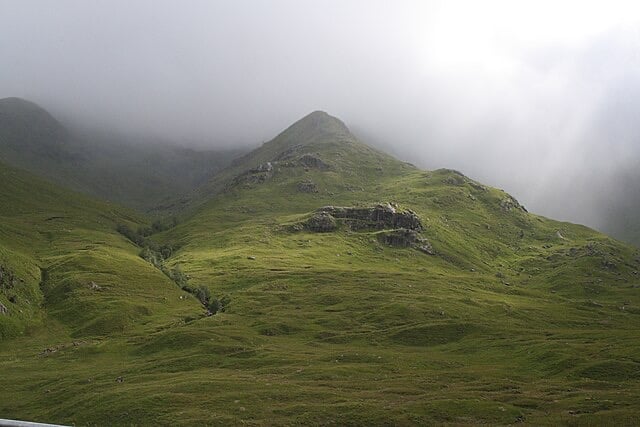Residents in the tiny Scottish Highland village of Inchlaggan felt their houses “shaking” and heard “a loud boom” as a 3.1 magnitude earthquake struck at 4:45pm on Friday.
The British Geological Survey (BGS) confirmed the tremor occurred at a depth of 8km beneath the remote village, with an impact zone spanning approximately 24km. The earthquake, centred near Fort William, was felt across a wide area of the Scottish Highlands, marking the strongest seismic event in the region this year.
Local residents took to social media to describe their experiences of the quake, which lasted several seconds and caused buildings to rattle and shake. One Muirshearlich resident reported on Facebook: “Felt it in Muirshearlich. Sounded like a big helicopter flying very low over the house. The house shook and there was a boom noise.”
Widespread Reports Across Highlands
The tremor was felt across numerous Highland communities, with reports flooding in from Fort William, Roy Bridge, Inverinate, Glenshiel, and Morvich. Another resident added: “Heard it the house shook thought it was the quarry blasting.”
A Knoydart local confirmed: “Felt the house move in Knoydart,” whilst someone in Gairlochy claimed they “heard a loud boom and felt shaking.
One resident in North Laggan described hearing “a loud, low rumbling noise, like a roadroller driving on a tarmac road surface,” whilst another thought their washing machine had malfunctioned. “Yes. The house was shaking and rattling. I thought my washing machine had malfunctioned,” they wrote.
A witness near Caol, approximately 26km from the epicentre, reported: “Low rumbling underneath the house. The house gave a couple of creaks/cracks. Thought at first it might be thunder but actually felt the rumble through the floor.”
UK Experiences Seismic Surge
The Inchlaggan earthquake comes as scientists report an increase in UK seismic activity, according to analysis by the Daily Record. Britain has experienced more than 100 earthquakes this year alone, with at least nine recorded in just one week during July.
The surge in activity included a 1.1 magnitude quake at a depth of 9km in Dorrington, Shropshire, at 2:44am on 21 July. Less than 24 hours later, a 0.8 magnitude tremor was recorded 3km underground in Ormidale, Argyll and Bute.
The largest seismic events occurred on Sunday, 27 July, when two earthquakes measuring 3.2 in magnitude struck the Southern North Sea off the coast of Cromer. They registered at depths of 18km and 21km respectively.
That same night, a 0.8 magnitude tremor was felt in Llanddewi, Powys, Wales. Earlier in the week, earthquakes had also been detected beneath the Celtic Sea near St Davids.
Pattern of Recent Activity
Kilfinan experienced a 1.3 magnitude quake on 24 July, whilst Ormidale felt a 0.8 tremor less than ten minutes later. In Wales, a minor earthquake with a magnitude of 1.1 and depth of 4km shook Llangurig, Powys, in the early hours of 25 July.
The British Geological Survey records between 200 to 300 earthquakes in Britain annually, though most go unnoticed by the public. Approximately 30 earthquakes each year register a magnitude of 2.0 or larger and can be felt by residents.
Friday’s earthquake was classified as “light” on the earthquake intensity scale, typically causing vibrations similar to those from passing lorries. At magnitude 3.1, it falls well below the threshold for structural damage, which generally begins around magnitude 4.5.
Scotland’s Seismic History
The largest known Scottish earthquake on land occurred near Loch Awe in 1880, registering a magnitude of 5.2. The event was felt from Perthshire to Ballycastle in Northern Ireland, with lighthouse keepers as far away as the western Hebrides on Lewis and Barra reporting movement.
UK earthquakes, particularly in Scotland, are most often attributed to glacial rebound – a geological phenomenon linked to the Earth’s crust adjusting after ice sheet retreat. Until approximately 10,500 years ago, much of northern UK was covered by a thick layer of ice which compressed the underlying rocks.
As the ice melted, the crust began slowly rising back to its original position, a process that continues today and occasionally triggers earthquakes. This glacial isostatic adjustment, combined with regional tectonic stresses from the Mid-Atlantic Ridge, creates the conditions for Scotland’s modest seismic activity.
Expert Analysis
Despite the apparent increase in recorded earthquakes, BGS scientists maintain that global earthquake frequency remains relatively constant. The perception of increased activity often results from improved detection capabilities, earthquake clustering patterns, and enhanced global communications.
“There are a number of reasons why it might seem as if we are experiencing more earthquakes,” BGS experts explain. “Earthquakes in populated places are far more noticed than the many that occur in remote regions, so when, by chance, a run of earthquakes hit population centres, it appears that the number of events has increased.”
The BGS operates a network of sensors across the UK to monitor seismic activity, with the ability to detect earthquakes as small as magnitude 2.0 across most of mainland Britain. In areas with denser monitoring networks, even smaller tremors can be recorded.
Friday’s earthquake serves as a reminder that whilst the UK sits far from major tectonic plate boundaries, the Earth beneath remains geologically active, occasionally making its presence felt through tremors that rattle windows and nerves alike.
Follow for more updates on Britannia Daily
Image Credit:
This is a licensed photograph used in its original or cropped form:
- Scottish Highlands fog (July 2018) – English description: Scottish highlands fog 2018.jpg, depicting thick mist over the Scottish Highlands in July 2018, photo by Azerifactory, taken on 22 July 2018 with a Canon EOS 1000D, licensed under Creative Commons Attribution‑ShareAlike 4.0 International (CC BY‑SA 4.0)



